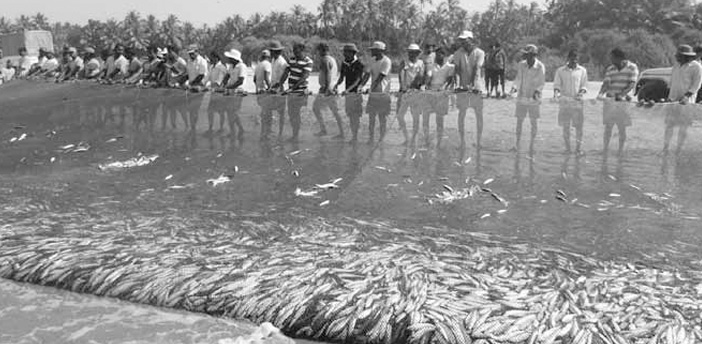The concept of food sovereignty is generally discussed in the context of land, farmers and agricultural production. In public forums, the discussion about food sovereignty is focused more on small farmers, environmentalists and indigenous peoples. Sovereignty entitles them all to define and play a significant role in their own agricultural, labour, fishing, food and land policies. The food sovereignty movement asserts policies that are ecologically, socially, economically and culturally appropriate for their specific local situations. The principles of food sovereignty incorporate the process of right to food, value for food, localised decision making capacity and also incorporates the sustainable mode of development.
Food sovereignty and coastal communities
In the context of the fishing community, food sovereignty leads to certain measures that should be taken up for the specific protection of coastal communities dependent on marine and inland fishing. Some of these measures include prevention or expansion of shrimp or aquaculture, and the destruction of mangroves, ensuring local fishing communities have rights to aquatic resources, negotiating a legally binding international convention to prevent illegal fishing, effectively implementing international marine agreements and conventions, such as the UN Fish Stocks Agreement, and eradicating poverty, and ensuring food security for coastal communities.
Fisheries are an important sector, contributing immensely to food security and livelihoods of the population. Fish is a great source of nutrition. The small scale fishery in Asia contributes to over 90% of the fishing population globally. Small-scale and artisanal fisheries face many challenges including depleted fish stocks (over exploitation of sea), pollution, encroachment for ‘development’, climate change and so on. It leads to threats of eviction and displacement due to development projects like SEZ, tourism, nuclear and thermal power plants, industrial aqua culture etc. Apart from these major issues of land, sea and water resulting in denial of small fishermen’s access to natural and productive resources for pursuing their livelihoods, there are a number of other challenges faced by this sector. The major concern is that many of the small-scale fishing communities are marginalised and their population is electorally fragmented, which lowers their political participation and access to decision making power. Also, there has been an increase in systematic violations of rights of indigenous fisher communities, and fisherwomen; there has been an improper implementation of policies which would otherwise have ensured an enabling space for small scale fishermen to exercise their human rights with dignity.
Whom does the sea belong to?
Amongst activists and researchers, the concern for land movement holds a greater importance than concern for marine resources and fishermen. Just like land, sea too is a natural resource. However, unlike land, which can be claimed for private or communal ownership, no one can claim or own the sea. Thus the sea being everyone’s and no one’s, it remains neglected, theoretically and physically. Also, the protests and movements from the fishing community remain limited to the coastal zone.
Economic relevance of fishing is important. Fishery is currently a source of livelihood for an estimated 500 million people, both as a source of income, and directly as a food source, especially in LEDCs (less economically developed countries). The Food and Agricultural Organisation (FAO) estimates that three billion people are being provided with their essential nutrition from marine ecosystems, and that at least 50 percent of animal protein provided to 400 million people from LEDCs come from fish. Thus, the sovereignty concerns of fishing communities with means of sustainable fishing are as relevant as anyone else’s.
The practice of sustainable fishing
The concept of sustainable fishing was introduced in the 1980’s. The core of this concept is to control illegal and rampant mode of fishing. The main agenda was to frame and develop the outlook of fishing policies. This concept even talks about the limitation of individual fish stocks in the context of environmental balance. Even the FAO provides voluntary guidelines for small scale fisheries.
A sustainable fishing method has its own ecological, economic, social and cultural dimensions. Social sustainability is based on local social customs, traditions, norms and taboos that local people are more likely to accept and adapt according to their own needs. Such people have a wealth of knowledge about their environment. They have social structures that manage and conserve common resources and maintain the social fabric. For instance, in the Sindhudurg district of Maharashtra, traditional fishermen have adopted the traditional method of fishing called rapan. It is more viable to their biodiversity in the region and has a cooperative base. For sustainability, indigenous knowledge should be preserved as sustainable practices rely heavily on traditional knowledge and local innovation systems.
The length of coastline in India is approximately 7000 kms, but it’s only 12 nautical miles from the baseline of a coastal state. The international territorial sea zone starts right beyond this boundary. In India, around 1.16 crore people are engaged in fisheries. India has 69 coastal districts excluding Andaman and Nicobar. This community though contributing in a big way to India’s GDP and to the nutrition needs of the country, lacks power to effect political changes.
During the formation of fishing policies, there is need of active participation of this community to preserve and conserve the coastal biodiversity. Coastal awareness campaign in the society is important. India prohibits fish processing units, land reclamation, discharge of untreated wastes and effluents from industries and cities, and sand mining in its coastal zone. But setting up ports, harbours and developing the waterfront are allowed in the area, for which they require CRZ clearance. Government has definitely made good provisions for ecological protection and the fishing community benefits as well, but there is a lack of political will. Turmoil in so-called development projects leads to destruction of life of the landless fishing community.
The UPA Government had introduced a very unique scheme of a ‘model fishing village’, which included basic water, sanitation facilities, with the main focus on improving livelihood. But this scheme has not been adopted by many states. Sadly, this pro-fishing community scheme has not reached its beneficiary communities.
The national green tribunal and green court control the anomalies in development projects. But the main drawback in this is that the problems of the fishing community are seen in the context of ecology alone. This problem must be dealt and discussed within the context of food sovereignty. Environment and human livelihood are interdependent, so environment and issue of livelihood must be discussed in this larger perspective.


